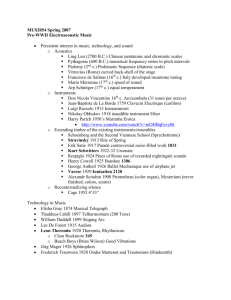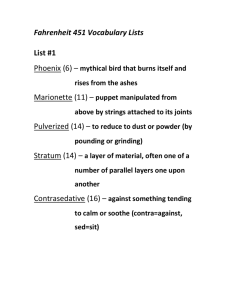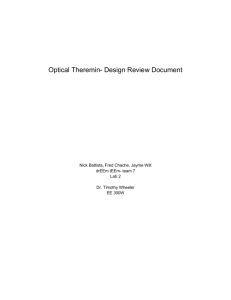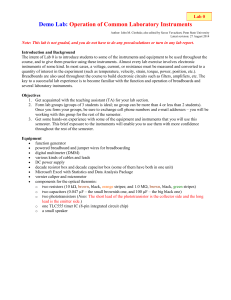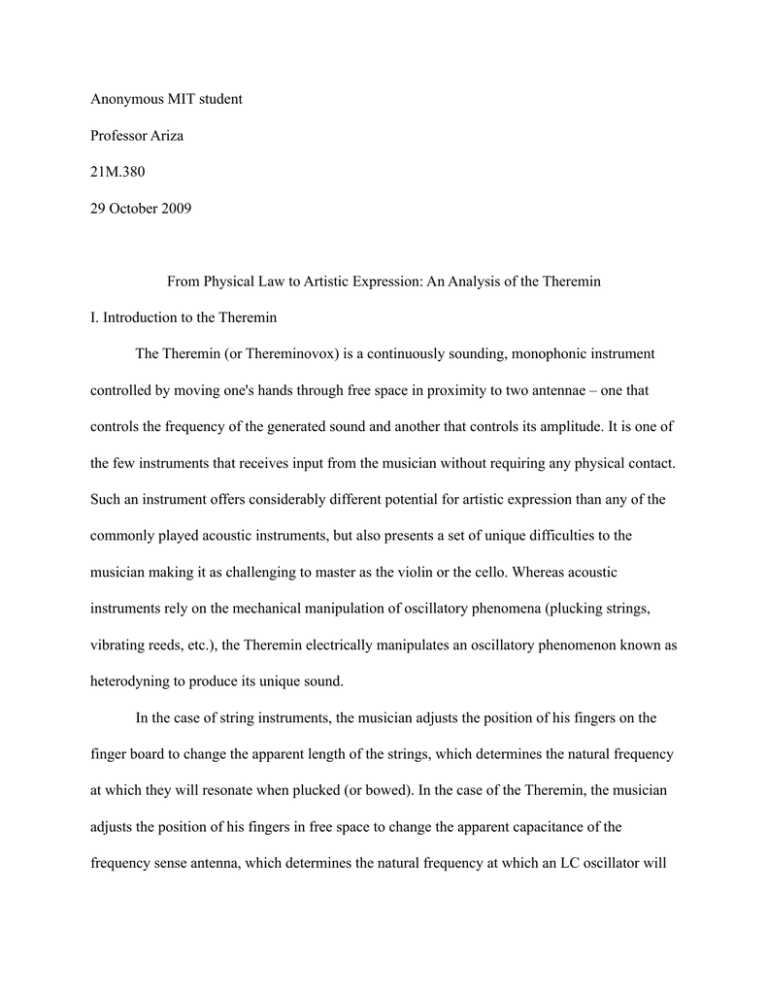
Anonymous MIT student
Professor Ariza
21M.380
29 October 2009
From Physical Law to Artistic Expression: An Analysis of the Theremin
I. Introduction to the Theremin
The Theremin (or Thereminovox) is a continuously sounding, monophonic instrument
controlled by moving one's hands through free space in proximity to two antennae – one that
controls the frequency of the generated sound and another that controls its amplitude. It is one of
the few instruments that receives input from the musician without requiring any physical contact.
Such an instrument offers considerably different potential for artistic expression than any of the
commonly played acoustic instruments, but also presents a set of unique difficulties to the
musician making it as challenging to master as the violin or the cello. Whereas acoustic
instruments rely on the mechanical manipulation of oscillatory phenomena (plucking strings,
vibrating reeds, etc.), the Theremin electrically manipulates an oscillatory phenomenon known as
heterodyning to produce its unique sound.
In the case of string instruments, the musician adjusts the position of his fingers on the
finger board to change the apparent length of the strings, which determines the natural frequency
at which they will resonate when plucked (or bowed). In the case of the Theremin, the musician
adjusts the position of his fingers in free space to change the apparent capacitance of the
frequency sense antenna, which determines the natural frequency at which an LC oscillator will
2
resonate. While the violinist changes the natural frequency of a mechanical oscillator by
adjusting the position of his fingers in one dimension, the Thereminist changes the natural
frequency of an electrical oscillator by adjusting the position of his fingers in three dimensions.
Both instruments offer the ability to produce a continuous range of frequencies, as opposed to
brass instruments that offer only discrete frequency control. In more ways than one, the
Theremin is analogous to the violin, and is capable of performing the same musical role in an
ensemble. However, although the Theremin is analogous to the violin in terms of input and
output, no acoustic instrument shares the same physical principles of operation with the
Theremin and hence no acoustic instrument can offer its unique musical capabilities.
The Theremin is a remarkable innovation in both electronics and music, and unlike the
violin its design did not evolve over centuries eventually resulting in its present day form. The
Theremin is the product of a single electrical engineer, Lev Sergeyevich Termin, known in the
United States as Leon Theremin. Theremin's engineering expertise in RF electronics led him to
develop the instrument as well as several others, each with unique properties and musical
capabilities. This study aims to trace the historical trajectory of the Theremin, beginning with its
inventor and ending with its virtuosos. In doing so, the progression from physical law to musical
expression will be described in detail.
Another aim of this study is to explain how Theremin designed the electronics of the
instrument from a theoretical perspective for specific sonic capabilities, and how musicians
eventually came to manipulate these sonic capabilities from a musical perspective by
understanding the Theremin as an instrument as opposed to an electronic circuit. This analysis
will attempt to bridge the gap between the science and the art of manipulating sonic systems.
3
Section II of this paper will examine the life of Leon Theremin and the motivations for his
inventions. Section III will go into considerable technical detail about the electronics of the
Theremin and summarize the physical principles on which it operates. Finally, section IV will
characterize the use of the Theremin by its most famous virtuosa, and how from an artistic
perspective she interpreted the device that Leon Theremin devised from a theoretical perspective.
Section V will draw conclusions.
II. The Career and Inventions of Leon Theremin
Leon Theremin was born in 1896 in the city of St. Petersburg, Russia. During his youth,
Leon Theremin took a particular interest in physics, electricity, and oscillatory motions such as
that of the pendulum1 . During high school, Theremin studied cello at the St. Petersburg
Conservatory of Music and graduated as “free artist on the violoncello”. After high school,
Theremin studied physics and astronomy at the University of St. Petersburg, and eventually also
received training as an electrical engineer during his Russian military service in World War I.
Following the Bolshevik revolution, a surge of academic energy permeated the Soviet
Union. Scientists, engineers, and students of all fields were heavily encouraged to conduct
research and experimentation in new and ground-breaking subjects. The Soviets hoped to usher
in a new era of discovery to accompany their newly created “egalitarian” society. Part of this
effort involved the founding of the Institute of Physical Engineering in St. Petersburg, by Abram
Fedorovich Ioffe, a Soviet physicist who went on to win the Stalin Prize in 1942.
After the war, Theremin received an invitation to begin working at the Institute of
Physical Engineering. Ioffe intended for Theremin to work in the field of high frequency
1
"Leon Theremin: Pulling Music Out of Thin Air", by Olivia Mattis and Robert Moog,
Keyboard, February, 1992, pp.46-54.
4
electrical oscillators. Theremin proceeded to work with contemporary radios and study the effect
of body position on radio signals2. The original application for Theremin's research was a
security system that involved sensing the presence of humans by detecting fluctuations in radio
signals. In 1920, Theremin extended the idea of detecting humans based on signal fluctuations to
creating signal fluctuations that were controllable by body position. In a certain sense,
Theremin's idea for a musical instrument was that a human could “play” the detector by
adjusting body position to create a controllable signal in the audio range.
An important question that arises naturally at this point in the timeline is what motivation
would Theremin have for applying the basis for his security device as the basis for a musical
instrument – a seemingly completely unrelated technology. Conveniently, Theremin answered
exactly this question in his 1991 interview with Olivia Mattis and Robert Moog. When asked,
“Why did you make this instrument,” Theremin replied,
“I became interested in bringing about progress in music, so that there would be more
musical resources. I was not satisfied with the mechanical instruments in existence, of
which there were many. They were all built using elementary principles and were not
physically well done. I was interested in making a different kind of instrument. And I
wanted, of course, to make an apparatus that would be controlled in space, exploiting
electrical fields, and that would use little energy.”3
“Musical Applications of Electric Field Sensing”, by Joseph A. Paradiso and Neil Gershenfeld,
Computer Music Journal, Vol. 21, No. 2 (Summer, 1997), pp. 69-89.
2
"Leon Theremin: Pulling Music Out of Thin Air", by Olivia Mattis and Robert Moog,
Keyboard, February, 1992, pp. 46-54.
3
5
At the beginning of the Bolshevik era, engineers were racing to find new and exciting uses for
electricity. Theremin's goal was to harness the power of electricity to eliminate the need for
mechanical work in operating an instrument. Theremin intended to build an instrument that
required very little energy to operate but could produce sounds that varied widely in amplitude
and pitch. In this sense, the Theremin is also analogous to the baton a conductor uses to conduct
an orchestra. Simple swift hand motions are all that is necessary to control an audio signal with
considerable power. The power is introduced into the audio signal via electronic amplification, as
opposed to the manner in which musicians of acoustic instruments generate powerful sounds by
means of mechanical work. Theremin's attitude toward bringing about the opportunity for
musical change reflects the general attitude toward radical innovation in the beginning of the
Bolshevik era. Part of the reason for Theremin's striking success with his instrument was that this
attitude was shared among scientists and political figures alike.
Theremin first showcased his instrument at an electronics conference in Moscow, where
it was received with great enthusiasm by his fellow engineers and inventors. The instrument
gained so much popularity and publicity at the conference that once Vladimir Lenin learned of its
existence, he requested that Leon Theremin give him a personal demonstration of this new and
ground-breaking musical apparatus. To demonstrate the musical potential of the instrument,
Theremin played “The Lark” by Glinka's during his visit with Lenin. Lenin enjoyed the selection
so much that after the applause subsided, he asked Theremin to show him to play the instrument
himself.
The Theremin was not the only electronic instrument that Leon Theremin devised during
his career. He also designed an electronic cello that Edgard Varése (one of the first composers to
6
pioneer electronic music) included parts for in his 1934 composition Ecuatorial. Theremin's cello
was controlled by making contact between the musician's fingers and the fingerboard. So long as
a finger was depressed, a tone was generated with frequency dependent on the position of the
finger. In addition to the electronic cello, Theremin also designed a machine called the
Rhythmicon – a precursor to the modern sequencer and drum machine. The Rhythmicon
produced one fundamental pitch and gave the musician the ability to control which of its
harmonics were also played. Each harmonic was played as a sequence of repeating tones, with
the repetition rate dependent on the number of the harmonic. By selecting combinations of
harmonics, the musician could generate complex rhythmic patterns electronically – another
radically new “musical resource” that Leon Theremin designed.
Lastly, Theremin designed an instrument called the Terpsitone. The Terpsitone was a
platform on which a dancer moved in space to control the pitch and amplitude of a generated
sound. Like the Theremin, the properties of the generated sound depended on the effect of the
position of the human body on an electric field; however, the Terpsitone required full body
movements as opposed to small hand gestures. It effectively converted the motions of a dance
into sound. The dancer would raise or lower his arms to control the pitch of the sound, while
moving forward or backward to control the amplitude.
III. The Design and Operation of the Theremin
Theremin's space-controlled instruments gave the musician the ability to control sound
through a completely novel interface that relied on the exploitation of physical principles to
operate. The method by which the motion of the musician's hands control the Theremin's sound
without physical contact is known as capacitive sensing, and is the same zero-contact detection
7
mechanism by which Theremin's security device worked. The basis for capacitive sensing is that
the position of the human body relative to an antenna changes the capacitance of the antenna.
The antenna is connected to a circuit in which its capacitance determines the resonant
frequency of an inductor-capacitor (LC) oscillator. Changing the antenna's capacitance changes
the frequency at which the LC circuit oscillates, and this is the basis for controlling sound.
However, as we will soon see, the Theremin's audio output signal is not taken directly from the
body position controlled LC oscillator. The fluctuations in antenna capacitance due to changes in
body position are extremely minute, and thus it is necessary to combine the LC oscillator
accompanying electronics to turn the small frequency fluctuations into audible ones. The signal
processing technique that Theremin implemented to accomplish this task is called heterodyning,
and we will examine it in detail after first describing the physics of how body position
determines the antenna capacitance.
The capacitance of a cylindrical antenna in isolation (with no human present) is given by
the following expression4:
Ca (∞) =
2πε 0 h
2h
log( ) − k
d
in which h is the antenna height, d is the antenna diameter, k is a constant depending on high the
antenna is positioned above the ground, and ɛ0 is the permittivity of free space (8.854 picofarads
per meter). The expression effectively tells us the capacitance of the antenna when the hand is
“Physics of the Theremin”, by Kenneth D. Skeldon and Lindsay M. Reid, American Journal of
Physics, Volume 66, Issue 11, pp. 945-955 (1998).
4
8
not present, or infinitely far away. The change in the antenna’s capacitance that results from the
hand being positioned at distance x from the antenna is given by 5:
ΔCa (x) =
πε 0 h
4x
10 log( )
d
The total capacitance of the antenna with the hand positioned at distance x is:
Ca (x) = Ca (∞) + ΔCa (x)
Now that we have a formula for the antenna’s capacitance as a function of hand position, we may
examine LC oscillator network that surrounds it to determine how the oscillator’s resonant
frequency fluctuates depending on the antenna’s capacitance, and hence on the position of the
musician’s hand.
Figure 1: Oscillator circuit with output frequency dependent on antenna capacitance.6
© American Institute of Physics. All rights reserved. This content is excluded from our
Creative Commons license. For more information, see http://ocw.mit.edu/fairuse.
“Physics of the Theremin”, by Kenneth D. Skeldon and Lindsay M. Reid, American Journal of
Physics, Volume 66, Issue 11, pp. 945-955 (1998).
5
“Physics of the Theremin”, by Kenneth D. Skeldon and Lindsay M. Reid, American Journal of
Physics, Volume 66, Issue 11, pp. 945-955 (1998).
6
9
The resonant frequency of the LC oscillator seen on the left-hand side of the schematic for the
Colpitts oscillator circuit is given by 7:
1 ⎛ 1
1⎞
f0 =
+
2π L ⎜⎝ C1 C2 ⎟⎠
1/2
in which C1 is the value of the capacitor C1 as shown in the schematic and C2 is the parallel
capacitance of the capacitor C (as shown), any stray capacitance between the antenna and
the rest of the circuit (Cs), and the antenna capacitance (CA). It seems reasonable to assume
that the output of the Colpitts oscillator could be used as the audio output of the Theremin, since
the frequency of this signal can be manipulated by hand position. However, due to the
mathematical relation between hand position and resonant frequency, large variations in hand
position lead to very small variations in the output signal of the Colpitts oscillator. Theremin
implemented a technique called heterodyning to transform the small fluctuations in the frequency
of the Colpitts oscillator to large fluctuations in the frequency of an audible output signal.
The concept of heterodyning was first applied to the design of a musical instrument in
1915 by Lee DeForest in his invention of the Audion Piano8. The basis for heterodyning is that
when two sinusoidal signals are mixed, the output signal has two frequency components equal to
the sum and the difference of the input signals. In signal processing, the mixing operation
“Physics of the Theremin”, by Kenneth D. Skeldon and Lindsay M. Reid, American Journal of
Physics, Volume 66, Issue 11, pp. 945-955 (1998).
7
“Electronic and Experimental Music: Technology, Music and Culture”, by Thom Holmes. New
York: Scribner, 2008.
8
10
corresponds to multiplying two signals. We can verify the output of the mixing operation with a
simple trigonometric identity 9:
Vout = Vin,1 × Vin,2 = A1 sin(ω 1t) × A2 sin(ω 2t)
Vout =
A1 A2
( cos((ω1 − ω 2 )t) − cos((ω1 + ω 2 )t))
2
We can eliminate the frequency component equal to the sum of the two frequencies easily by
cascading the mixer with a low-pass filter, outputting a waveform with frequency equal to the
difference of the two input frequencies, called the “beat” frequency. By pairing two highfrequency Colpitts oscillators together, one oscillating at a fixed frequency and one with a
frequency fluctuating due to changes in antenna capacitance, and applying the necessary
heterodyning circuitry to their outputs, Leon Theremin was able to transform minute fluctuates in
antenna capacitance into large fluctuations in the audible beat frequency of the two oscillators.
Recall that changes in antenna capacitance are small, and hence they produce very small
fluctuations in the output frequency of the antenna dependent Colpitts oscillator. If the antenna
dependent Colpitts oscillator rings nominally at 1 MHz, a small change in antenna capacitance
might have the effect of changing its frequency by 1 kHz (a 0.1% fluctuation)10. However,
assuming that the fixed oscillator also rings at 1 MHz, the difference of the two signals would be
1 kHz - an audible signal. In order for the beat frequency to sweep the entire audible frequency
range (20 Hz to 2 kHz), the nominally 1 MHz frequency would need to fluctuate by at most
0.2%. A musician moving his hand in close proximity to the antenna is certainly capable of
“Physics of the Theremin”, by Kenneth D. Skeldon and Lindsay M. Reid, American Journal of
Physics, Volume 66, Issue 11, pp. 945-955 (1998).
9
“Physics of the Theremin”, by Kenneth D. Skeldon and Lindsay M. Reid, American Journal of
Physics, Volume 66, Issue 11, pp. 945-955 (1998).
10
11
producing this fluctuation by means of changing the antenna capacitance. In an actual Theremin,
the antenna-dependent Colpitts oscillator would be configured to ring at the same frequency as
the fixed oscillator when the antenna capacitance was set to Ca(∞), effectively producing a beat
frequency of 0 Hz (no sound) when the operator’s hand was far enough away from the antenna.
As the operator moved his hand closer, the antenna capacitance would change, causing greater
and greater fluctuations in the antenna-dependent oscillator frequency, which caused the beat
frequency of the two oscillators to increase through the audible range.
Theremin also included another heterodyned oscillator pair for the purpose of volume
control. The beat frequency of the two oscillators was controlled in exactly the same manner as
that of the pitch oscillators (antenna capacitance); however, the beat frequency instead of being
used as an audio output was passed through a band-pass filter. As the musician moved his hand
in close proximity to the volume antenna to change the beat frequency of the volume oscillators,
he effectively tuned the beat frequency into the pass-band of the filter11. The filter’s output was
then applied to an envelope follower and used as the control voltage for a voltage controlled
amplifier (VCA) that amplified the audio output of the Theremin (the beat frequency of the pitch
oscillators). In this manner, a certain range of hand positions would maximize the amplitude of
the band-pass filter’s output, and hence the control voltage of the VCA, in effect maximizing the
volume of the Theremin’s audio output. Overall, the Theremin required moving two hands in
proximity to two antennae, one for pitch and one for volume. Theremin engineered the
instrument to allow for smooth, continuous control over pitch and similarly a wide range of
control over dynamics. The virtuosos of the Theremin, provided with this engineered space
“Musical Applications of Electric Field Sensing”, by Joseph A. Paradiso and Neil Gershenfeld,
Computer Music Journal, Vol. 21, No. 2 (Summer, 1997), pp. 69-89.
11
12
controlled interface, were able to develop an intuition for understanding its subtleties and learned
how to skillfully manipulate its sound.
IV. Clara Rockmore
One of the most famous Thereminists of the 20th century was Clara Rockmore, a
classically trained violinist who was accepted as the youngest ever violin student at the St.
Petersburg Imperial Conservatory at the age of four12 . In 1977, Robert Moog gave Rockmore an
interview to be published at the same time as her newest record, The Art of the Theremin. In this
interview she explained how she manipulated the Theremin as a musical instrument, as opposed
to a merely sound-generating electronic circuit. When asked to explain the musical limitations of
the Theremin, Rockmore replied:
“The violin has four strings, which makes a big difference. What I do on the theremin is
the same as a cellist would do if he had one string. It's that much more difficult. For
instance, there is a very easy Handel violin sonata where you play rapidly from string to
sting. It's very difficult on a theremin, because you have to use time to go the distance ... I
adopted the violin vibrato for the theremin, but it's with the other hand. I try to emulate
the violin bowing technique with my left hand. Since the theremin tone is constant, I have
to artificially create a 'breath'.”13
Although the Theremin circuitry gives the musician only the simple facility to control the
volume and pitch of the generated sound, Rockmore developed techniques to emulate the sound
“The World of Women in Classical Music”, by Dr. Anne K. Gray. San Diego: WordWorld Publications, 2007. http://www.nadiareisenberg-clararockmore.org/clara_biography.htm
12
“In Clara’s Words”, by Robert Moog. October 27, 2002. http://www.thereminvox.com/article/
articleview/21/1/22/
13
13
of the violin by skillfully combining the two interface controls simultaneously. When asked what
the unique advantages of the Theremin were, Rockmore answered:
“...Very fine violinists have a long bow. But as long as their bow may be, mine is longer.
You have a musical nuance right there. A singer may have to take breaths even when it's
not musically desirable, because he cannot continue to sing. I take the breaths when I
think it's musically valid or necessary. I create a breath. I do it deliberately. I never
do it because it's necessary. I can choose when I take it so it suits the music.”14
It is clear that because of her extensive experience with the violin, Rockmore interpreted in terms
of its relationship to the violin and relative capabilities. Rockmore explained that she uses her
Theremin techniques (“bowing”, “breathing”, and vibrato) to liken the sound of the Theremin to
that of a common instrument. However, the same features (continuously sounding tone,
continuous pitch and volume) of the Theremin that require the musician to use special techniques
to shape its sound into something musical are the features that give the Theremin the capability
to exceed the performance of a common instrument. Rockmore remarked that with the Theremin,
she has absolute control over when (or never) to breath.
One of Rockmore’s most significant comments involves her interpretation of the
Theremin as a musical interface:
“There are certain nuances and qualities that you can obtain because you don't have
anything in your hand. It really comes out of the air. That's why Prof. Theremin called it
“In Clara’s Words”, by Robert Moog. October 27, 2002. http://www.thereminvox.com/article/
articleview/21/1/22/
14
14
the Ether Wave Instrument. There is a certain terrific freedom. You feel like a conductor
in front of an orchestra. There is no instrument between you and the music.”15
This quotation proves Leon Theremin’s success as the engineer of the instrument. His original
design goal was to empower the musician with extensive freedom over the produced sound by
eliminating the need for the expenditure of mechanical energy. In his 1991 interview with Robert
Moog, Theremin remarked, “I conceived of an instrument that would create sound without using
mechanical energy, like the conductor of an orchestra.”16 And this is exactly the freedom that
Clara Rockmore harnessed to become the leading virtuosa of the Theremin in her time.
V. Conclusions
“In Clara’s Words”, by Robert Moog. October 27, 2002. http://www.thereminvox.com/article/
articleview/21/1/22/
15
"Leon Theremin: Pulling Music Out of Thin Air", by Olivia Mattis and Robert Moog,
Keyboard, February, 1992, pp.46-54.
16
MIT OpenCourseWare
http://ocw.mit.edu
21M.380 Music and Technology (Contemporary History and Aesthetics)
Fall 2009
For information about citing these materials or our Terms of Use, visit: http://ocw.mit.edu/terms.

